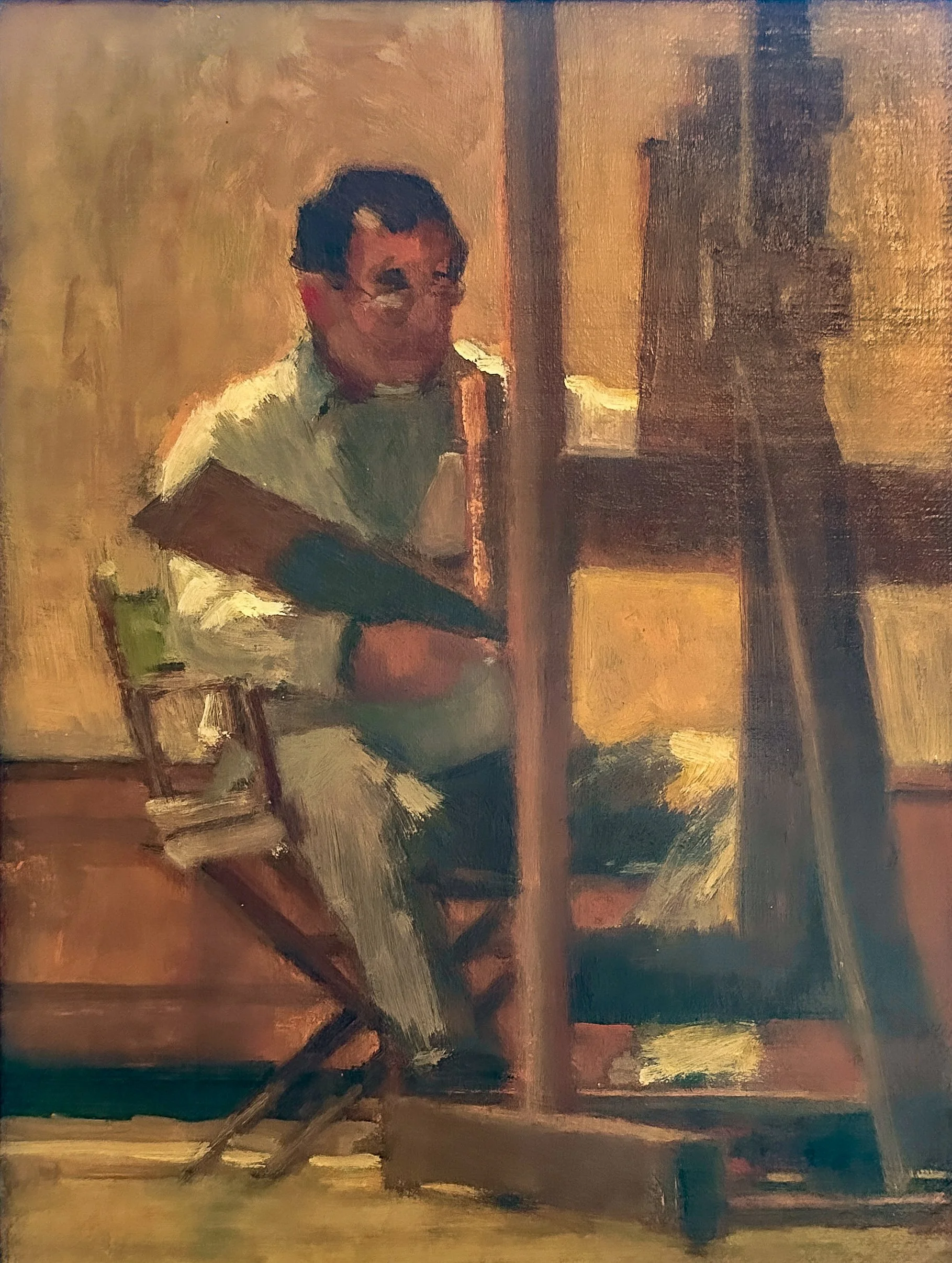Jack Boul, Self Portrait, 1985, oil on canvas. Collection of the artist.
The premier of a suite of modern classical music inspired by Jack Boul’s paintings will be held at the Blowing Rock Art and History Museum on September 27 at 4 pm. After the concert, visitors are invited to tour the exhibition of Boul’s paintings. This inaugural concert will be performed by the Faculty Ensemble of the Hayes School of Music at Appalachian State University and is open to the public. The music was composed by Roger Tréfoussse who met Jack Boul in the 1960s when he was a music counselor at Camp Catawba in Blowing Rock. Subsequent performances of this music will be performed in Washington DC, New York, and Berlin Germany.
Notes on the piece from the composer, Roger Tréfousse
Sound and Sight: A Collaboration Jack Boul/Roger Tréfousse was born in a moment of chance and synchronicity. The piece originated when Jack Boul’s paintings and drawings were being exhibited at the Salmagundi Arts Club in Greenwich Village, New York City. David Boul, the painter’s son, was overseeing the exhibit, and saw the program for a concert taking place there that week, featuring my music for the PBS film, Jackson Pollock: Portrait. Boul remembered me from Catawba, Vera Lachman’s legendary arts camp in western North Carolina--we had both been there as campers but had not seen each other since. This chance meeting led David, inspired by my music for the Pollock film, to ask if I’d be interested in writing music based on a group of his father’s paintings.
I immediately felt drawn to this project. Boul’s paintings are classic in content, but they also have a modernist sensibility, and my music, grounded in traditional musical thought is also very
connected to modernist musical ideas. And since writing music for the Pollock film, I’ve continued my interest in music and painting--most recently in Don Bacardy Paints a Portrait.
In Sound and Sight: A Collaboration Jack Boul/Roger Tréfousse, my music is a study of tonality and vibration of color and line in painting translated into music. The musical soundscape for this
Suite embodies my unique combination of elements: tonal, non-tonal, classical, jazz and free improvisation.
While Boul’s paintings are a realistic and often intimate depiction of places, people and events, they have an underlying, almost secretive connection to abstract color and line. Meditating on
these paintings has led me to create music both constantly improvisatory and at the same time, highly structured. Quickly changing complex passions contrast with quieter thoughts that
grow, diminish and change slowly in unexpected ways.
The Suite is scored for eight instruments: oboe, tuba, piano, two violins, viola and two cellos. In this orchestration, I’ve moved away from my usual chamber music combination of wind groups and one or two strings because the unexpected and ever-changing overlay of textures and colors that are an essential aspect of Boul’s palette called for something radically different.
Multi-layered and sonically varied string writing seemed essential, juxtaposed and combined in unexpected interludes and dialogues with the piano and with the oboe and tuba in their full range of colors. There are eight pieces making up a whole, each based on a different painting in a developing and integrated sequence. The Suite begins with Catawba, a tonal piece for solo piano in response to a lyrical painting looking down a hill at Camp Catawba and ends with a complex eight-instrument piece for Self Portrait. The sequence of the inner pieces, scored for all eight instruments, encompasses the major elements of Boul’s work: Museum Guard, a depiction of an intimate moment in time; Two Cows, a study of the animals he most loved to paint, in this case, with an understated but complex background; Canal, a shimmering, abstract landscape; Clouds, a classic and gorgeously lyrical modern study; Reflections, a complex journey of relations between people and place and Tango, a sensuous dance, both provocative and lighthearted.
I note the influences in this music of my teacher, pianist Grete Sultan, who played Schubert as if it were John Cage and the music written for her by Cage as if it were by Bach, and my three composition teachers: Tui St George Tucker, microtonal, modernist composer; John Cage, who opened musical composition to chance while still remaining very connected to Schoenberg’s ideas and Ben Weber, the first American twelve-tone composer. Sultan allowed her playing to go out on a high wire in outer space while still maintaining structure and control, and I had the same goal in mind in writing these pieces, allowing my musical thought to move freely into improvisational worlds. Like Cage, this music uses chance elements as well as pairings of random, unplanned combinations of tone and phrase; like Weber, an ongoing respect for non-repetitive note formations and non-tonal sections which segue unexpectedly into the tonal; like
St George Tucker, a blending of jazz and popular musical elements, Baroque counterpoint and complex dissonances and rhythms.
Learn more about composer Roger Tréfousse: https://www.rogertrefoussemusic.com


